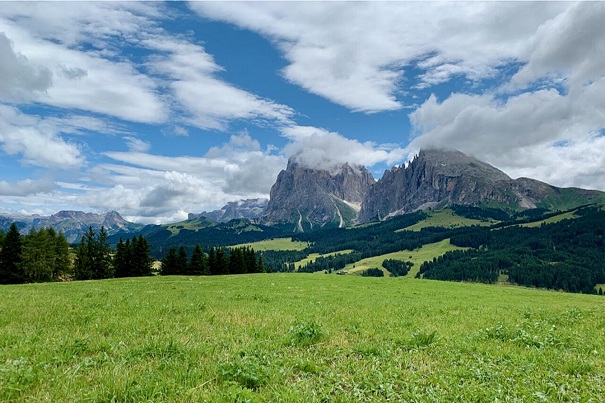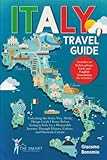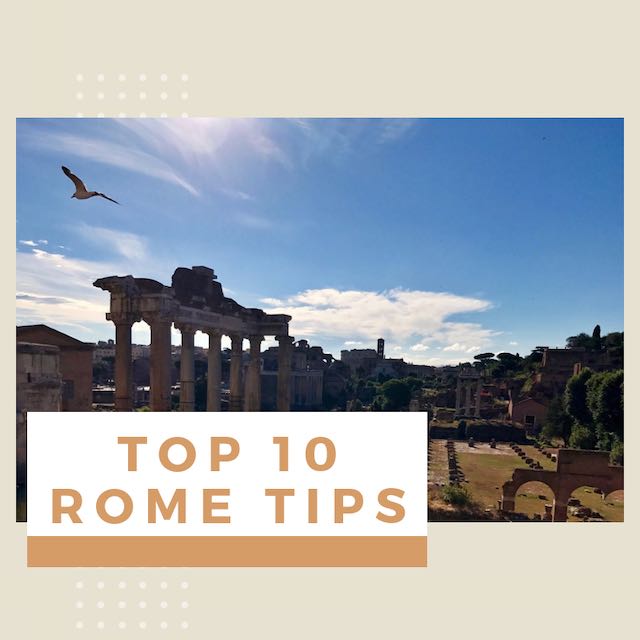- Sign up & get a FREE ebook Subscribe NOW!
- Romewise Home Page
- What to Do in Rome
- Visit the Dolomites
Visit the Dolomites
When we decided to visit the Dolomites, I was pretty excited about the idea of summer hiking there.
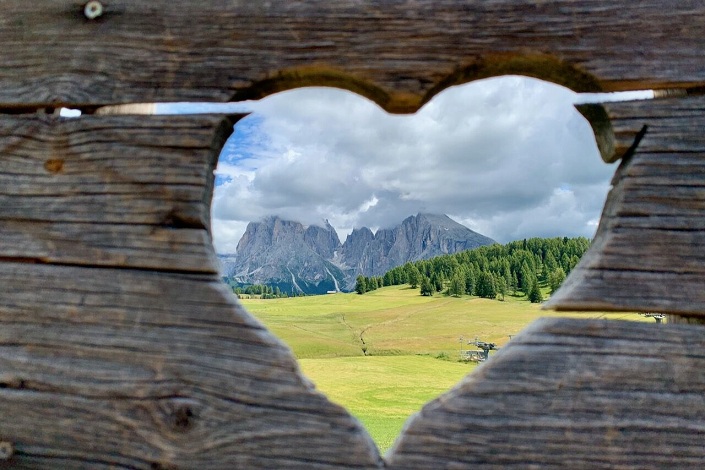 Everywhere you look in the Dolomites, you just want to snap a photo. This cute wooden frame with a heart-shaped hole was obviously put there for this purpose. I have no problem with that!
Everywhere you look in the Dolomites, you just want to snap a photo. This cute wooden frame with a heart-shaped hole was obviously put there for this purpose. I have no problem with that!I was not at all prepared for how much they would blow me away.
I am now in love with them and can’t wait to get back as often as we can.
Here’s why the Dolomites should be on your bucket list.
Visit the Dolomites – a mountain oasis
Because this website is about Rome, I’m here to tell you that you CAN visit the Dolomites from Rome and vice-versa.
If you are looking to combine your city tourism with something more outdoors, more relaxed, something different, why not consider the Dolomites?
On this page I’ll cover:
- What are the Dolomites and why visit them?
- Where are the Dolomite mountains?
- How to get to the Dolomites
- How to get around
- Best time to visit Dolomites? How long to stay?
- What to pack to visit the Dolomites
- Where to stay in the Dolomites?
- Things to do in Dolomites
- What language do they speak in the Dolomites?
- Foods to try in the Dolomites
- Dolomites Italy map of places we stayed, ate, and hiked
 The Dolomites are a popular ski destination, but we love them in summer, with these colorful and fragrant mountain flowers dotting the landscape.
The Dolomites are a popular ski destination, but we love them in summer, with these colorful and fragrant mountain flowers dotting the landscape.What are the dolomites and why visit them?
The Dolomites are a mountain range in the north of Italy.
They form the southern part of the Alps, which is the highest and most extensive mountain range in Europe.
The whole area was under water about 250 million years ago, which is why the rocks that make up these mountains contain fossilized coral.
Today the Dolomites are one of the most popular areas for Italians and many other Europeans to vacation in during winter or summer holidays.
The skiing here is world-class, the Christmas markets are traditional and charming, and the mountains in summer offer some of the most stunning and dramatic backdrops in the world for sports like hiking, paragliding, and cycling.
In 2009 the Dolomites were classified as a UNESCO World Heritage site.
Where are the Dolomite mountains?
The Alps mountain chain is huge and goes across most of the north of Italy (along with many other countries including France, Switzerland, and Austria).
The Dolomites are part of the Alps in the northeast of Italy, covering the regions of Belluno, Alto Adige (also called South Tyrol), and Trentino.
The tallest mountain is about 11,000 feet above sea level.
The Dolomites form the geographical border between Italy and Austria.
How to get there
Visit the Dolomites by train
 One way to get to the Dolomites is to take the high speed train to Bolzano and then drive from there.
One way to get to the Dolomites is to take the high speed train to Bolzano and then drive from there.From Rome, you can take a high-speed train to Bolzano.
It's a little over 5 hours on the high-speed train.
(We once took an overnight train, which takes almost 9 hours and goes very slowly. We went to sleep and woke up in the mountains.)
From there, you can get a bus, or rent a car.
You can also book a private day trip by car from Bolzano.
You can also take a driver/tour escort from Venice.
Visit the Dolomites by car
In my opinion, the best way to get to the Dolomites is by car, because once you're there, it's easiest to get around with a car.
You can rent a car directly from Rome or wherever else you are visiting.
Then you can travel at leisure and make the trip part of the fun.
VISIT THE DOLOMITES BY RENTAL CAR - IMPORTANT TIP!
If you want to rent a car in Bolzano, don’t arrive or depart on a Sunday because ALL the rental car agencies are closed on Sundays and you will not be able to rent one.
Best airport for dolomites
You can fly to nearby cities of Verona, Milan, or Venice, or Innsbruck, Austria.
From there I suggest renting a car.
Visit the Dolomites as a Day trip from nearby cities and towns
While the Dolomites merit a longer stay, you can visit them easily from nearby locations such as Milan and Venice.
If you are visiting the Lakes Region in northern Italy, you can visit the Dolomites on a tour from Lake Garda.
If you're in Milan, you can visit the Dolomites on this day trip from Milan.
If you visit Venice, you can easily visit the Dolomites as a day trip from Venice.
How to get around
Once you are in the Dolomites, the easiest way to get around is with a car.
But if you choose not to have a car, you can use local transportation.
Each town or group of towns has an easy-to-use bus system, and you can get a bus pass for the time you will be there.
But before you do that, check with the hotel you book.
Many of them offer these passes as part of your stay.
Dolomites cable car summer passes
If you plan to ski, cycle, or hike when you visit the Dolomites, you will also need a way to get up and sometimes down the mountains, and for that I recommend getting a lift-pass.
You can purchase passes as you go, but we realized too late that we should have purchased a pass, as we would have saved a lot of money.
 You will want to take cable cars up the mountains, whether it's to get to a hike or ski run, to enjoy a flat walk along a mountain-top, to soak up the views over a nice lunch, or just to take in the panoramas around you. It pays to get a multi-trip pass.
You will want to take cable cars up the mountains, whether it's to get to a hike or ski run, to enjoy a flat walk along a mountain-top, to soak up the views over a nice lunch, or just to take in the panoramas around you. It pays to get a multi-trip pass.Pass prices are:
- 1 day: 47 €
- 3 out of 4 days: 110 €
- 5 out of 7 days: 147€
- Summer card unlimited use: 350€
For more details, options, and discount information, visit the official website for ticket passes.
You may also be able to pick these up at your hotel or once you are there.
Each town or set of towns may also have their own passes just for the area.
Best time to visit the Dolomites
Visit the Dolomites in the winter
Many Italians love to go skiing in winter as part of a “settimana bianca” – or “white week”, which usually involves snow if not skiing.
This is not for us, as we love summer hiking.
But I do know that people who ski say the Dolomites are among the best places in the world for it.
The Dolomites are a skier’s heaven.
There’s a reason so many Olympic skiers come from this area, and there is a reason they’ve held winter Olympics here more than once.
Sign me up for the après-ski!
Enjoy a nice, private snowshoe-tour in the Dolomites!
Visit the Dolomites in the summer
We are summer people.
But Rome can get stiflingly hot in summer.
And hikers like us love to go to northern mountains in summer to escape the heat in Rome.
In the Dolomites, you can hike in comfortable temperatures due to the altitude.
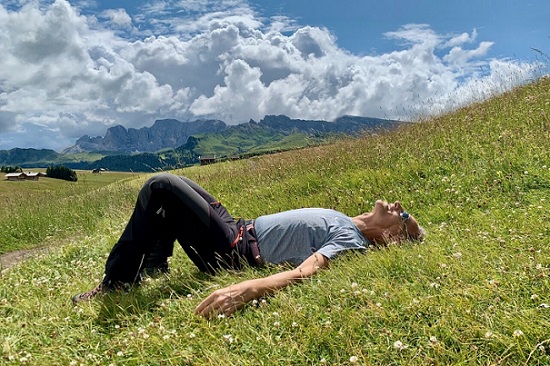 Alessandro soaking up the sun and enjoying a quick rest before we resume our summer hike in the Dolomites.
Alessandro soaking up the sun and enjoying a quick rest before we resume our summer hike in the Dolomites.Bolzano: Private Full-Day Hike through the Dolomites!
Cortina: Private Full-Day Hike through The Dolomites!
Ready to plan your trip?
Book your train
Planning to travel between cities in Italy and other parts of Europe?
Use Trainline to see all the different options available across the different rail companies.
Find your hotel
Find your perfect place to stay in Rome.
Use Booking.com to choose between hotels, guesthouses, and self-catering apartments in neighborhoods throughout the Eternal City.
Buy your TurboPass
Purchase the convenient Turbopass and visit all of Rome's top attractions including the Colosseum, Pantheon, and Vatican.
With one handy pass, it's all included.
How long to stay in the Dolomites?
We usually go for a week.
7 nights and 6 full days.
With a week, we like to hike most days but also take a couple of days off.
You could certainly go for 3-5 days, but I’d happily spend 10-14 days there.
It is really heaven!
Can you visit the Dolomites as a day trip?
Sure, if you are visiting someplace close like Venice, Milan, or Lake Garda, to name a few places.
Visit the Dolomites on a Day trip from nearby cities/towns
If you are visiting the Lakes Region in northern Italy, you can visit the Dolomites on a tour from Lake Garda.
If you're in Milan, you can visit the Dolomites on this day trip from Milan.
If you visit Venice, you can easily take a day trip and visit the Dolomites from Venice.
What to pack when you visit the Dolomites
If you are combining a visit to the Dolomites with a visit to Rome, you may find you need some different items in your luggage.
In particular, if you are heading to the Dolomites for some sports activities, you will want to take that into consideration.
What to pack for the Dolomites any time
Whether you are visiting the Dolomites for summer hiking, winter skiing, or just some fresh mountain air, here are some things you should pack when you come:
I can't tell you how much we regretted not having binoculars on our first hike in the Dolomites.
The mountains are enormous and the views are seemingly endless.
Once we bought binoculars in town, we used them on nearly every hike.
It's so rewarding to spot deer or other small animals as they try to camouflage and blend in with the mountain colors.
I never go anywhere, whether out and about in my daily life, or travelling, without my Anker battery pack.
Considering how much I use my phone, my battery needs recharging just about every time I am away from home!
One of my new favorite things to carry with me everywhere I go are these reusable stainless steel straws.
Good for the environment, and good for my health as I know where they have been.
Light, cheap, and so easy!
Don't forget to bring a good water bottle that you can use also while walking around Rome.
I don't know about you but I must have Tiger Balm with me when I travel.
Especially if I am doing sports activities like hiking.
They don't sell this in Italy (as far as I know), so bring it with you.
Your muscles will thank you!
What to pack for the Dolomites in summer
Summers in the Dolomites are a bit cooler than Rome.
But it can still be hot.
If you plan on hiking, don't forget these items:
I have hiked in summer in the Dolomites in long hiking pants and trust me, you will be much more comfortable in hiking shorts (or just gym or regular shorts, as long as they are comfortable.)
A very handy thing to pack for the Dolomites that you will also find useful for visiting Rome and other cities in Italy in summer, are these versatile hiking pants with removable bottom halves.
This way you can cover up for Vatican visits and stay cool in shorts outside.
I really cannot stress enough how important it is to wear a good hat with sunblock when visiting Italy in the summer.
This is definitely also handy in Rome.
If you plan to do any hiking at all, you'll need a pair of quality, sturdy hiking shoes. If you also visit Rome or other hot city, you may want to keep your luggage light by packing a light hiking shoe that you can also wear while tromping around the city.
Otherwise, you may want to opt for an even sturdier pair of ankle-high hiking boots.
If you are going to hike, you should have a decent backpack.
You should bring a light shell and rain jacket or poncho, as you never know when you are in the mountains.
You'll want water and maybe a snack bar or two, so even a small backpack is key.
A light rain shell is a must while hiking and it can also come in handy while visiting Rome, as you just never know when it might rain.
I have a pair of lightweight, collapsible walking sticks but to be honest I rarely use them when I hike in the Dolomites.
They are useful for descents, and for nordic-style walking when you are on a more or less level plain.
But for climbing up the mountains, especially where it's pebbly, I find the sticks get in my way.
But you might want to have a pair with you, either way.
What to Pack for the Dolomites in winter
If you visit the Dolomites in winter, you may just want to enjoy the cozy Christmas atmosphere.
You may also want to ski or snowboard, as this is a world-class area for these winter sports.
I am not a skier so am not able to tell you all the sports equipment you need when you visit the Dolomites in winter.
Where to stay in the Dolomites
We have stayed in different areas.
We love to stay in the town of Selva di Val Gardena.
Once we stayed at the Chalet Gerard, which we loved.
This hotel did not sponsor us.
We chose it based on reviews of friends who’d been skiing in the area and who’d told us that Chalet Gerard had one of the best restaurants in the area.
So we booked a “mezza-pensione” which means half-board.
We had an amazing buffet breakfast daily, and superb meals for dinner.
We ate our lunch out on the trails or in town.
The Chalet is slightly outside of Selva so to go into town we needed to drive and then pay to park.
I’d happily stay there again.
We loved the cuteness of the town of Selva and nearby Santa Cristina and Ortisei.
They are all close to each other and well connected in terms of roads, public transportation (if you need it), trails, and lifts.
You can find every type of lodging in the Dolomites from budget to luxury.
Best luxury hotels in Dolomites
Best inexpensive hotels in Dolomites
Hiking in Italy?
Here's everything you'll need
Disclosure: If you make a purchase through a link on this page, I may receive a small commission - at no extra cost to you. Thank you for supporting my site!
Things to do in the Dolomites
Some of the best things to do in the Dolomites involve outdoor recreation, such as skiing, snowboarding, hiking, cycling, trekking, and more.
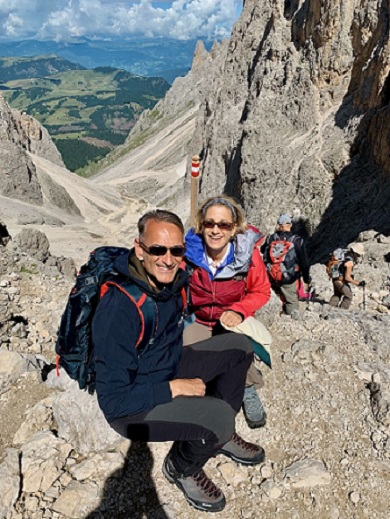 We chose to visit the Dolomites in summer for some fantastic hiking. It's a huge outdoor adventureland with opportunities to do so many things, from skiing, to climbing, to hiking, and more.
We chose to visit the Dolomites in summer for some fantastic hiking. It's a huge outdoor adventureland with opportunities to do so many things, from skiing, to climbing, to hiking, and more.If, like us, you want to visit the Dolomites to hike, click here to find some guided tours and best hikes in dolomites.
If you and/or your travel companion are not into these outdoor sports, there is still plenty to do.
If you go in December and up to the 6th of January, you can visit the Christmas markets.
You can shop in the small towns, and enjoy all the yummy, warm cozy bars and winter foods from the area (see below.)

If you are not much of a hiker, there are a lot of easy treks you can do by going all the way to the top of a mountain and walking around on mostly flat fields.
From there the views are second to none.
There are many hiking associations that go on these hikes/walks, and you can sign up with them in the town where you stay.
You can also ask at your hotel.
When you check with your hotel or a local travel agency about hikes, with or without a guide, you will be able to tell the difficulty level, the distance, and the amount of time the hike should take.
Two of the days we went with a guide (once through our hotel, and once with friends staying in the area who’d booked their own guide).
The other two days we went on our own.
There are so many maps, both physical (paper) and on site, and the trails are so well-marked, it’s easy to go on your own.
You will also see plenty of other people out hiking so you don’t have to worry much about getting lost.
 If you visit the Dolomites for hiking, you can go with a guide or on your own. The trails are so well-marked and you will often find maps like this.
If you visit the Dolomites for hiking, you can go with a guide or on your own. The trails are so well-marked and you will often find maps like this.It’s easy to rent bicycles, including electric bicycles, which is another fun way to get around and get exercise.
You might also want to engage in some indoor and outdoor spa treatments.
And again, even if you are not much into hiking or exercising, you can just enjoy the cute little towns, and take the lifts to the top of a mountain to relax over a scenic lunch.
 The Dolomites are full of "rifugi" where you can stop during your hike and enjoy a rest and/or meal. You can also usually sleep here, and many people do.
The Dolomites are full of "rifugi" where you can stop during your hike and enjoy a rest and/or meal. You can also usually sleep here, and many people do.Disclosure: If you make a purchase through a link on this page, I may receive a small commission - at no extra cost to you. Thank you for supporting my site!
What language do they speak in the Dolomites?
The official language in the Dolomites is Italian.
The unofficial language is Ladin.
And you will hear German spoken widely, thanks to the proximity to Austria, and also to its history as part of the Austro-Hungarian empire.
You can easily use English as many people speak and understand it there.
One of our local guides told us that when children are in school, they spend one week doing lessons only in German, the next week only in Italian, and the following week only in Ladin.
So all the locals we met spoke all three languages fluently.
And they also spoke pretty good English.
You will often find that many towns, roads, and hiking trails have both an Italian and Austrian name, and sometimes Ladin one too.
- German – The northern part of the Dolomites, called Südtirol in German and Alto Adige in Italian, were once part of the Austro-Hungarian empire. In World War One, the Dolomites was the site of devastating battles. There were a lot of mines placed around the mountains. As a result, vie ferrate or iron paths, were created as a way to get safely around without running into mines. You can climb these paths today. After the war, the region became part of Italy, but the German language remains spoken widely.
- Ladin – Ladin is an ancient Romance language, and it is still spoken in parts of the Dolomites. When we are in the Dolomites, we hear it spoken more than any other language. I have to stay to me it sounds Germanic and yet it’s actually more closely related to Italian since it is a Romance language.
- Italian – Italian is the national language of Italy so of course it is spoken everywhere in the Dolomites. You may find, however, that depending on where you are, the locals prefer one one of the other two languages.
Foods to try in the Dolomites
When we arrived at our hotel, it was early and our room was not yet ready.
We went to the bar/café on site, and got some Apfelstrudel, or apple strudel, a typical dessert of the area.
They asked if we wanted it with whipped cream, ice cream, or French vanilla cream.
Um, hello, French vanilla cream!!!
While the Dolomites are indeed part of Italy, the culture, language, and food have a long history related to its Austrian roots.
One of the things I loved about visiting the Dolomites was trying all the local food.
We did not look for, or even see on menus, Roman cuisine such as carbonara, amatriciana, etc.
The hotels tend to have delicious food so if you choose a mezza pensione (half-board that includes dinner), you can be sure to eat well.
We tend to eat lunch out on the trails at various rifugi that were well-organized and that offer excellent meals.

Here are just some of the delicious foods we loved eating while in the Dolomites.
These all seem to be heavy, rich foods, but when you hike as much as we did – or partake of any other mountain sports – you will not worry too much about these calories.
You will need them!
And even if you are not exercising – live a little!

Kaiserschmarrn – This is one of the most heavenliest foods I have ever eaten.
They are torn egg/flour/sugar pancakes cooked in butter and served with fresh jam.
I could eat this until I burst.

Canederli – Canederli are a kind of large bread dumpling usually containing speck (ham).
It’s typical to find Tris di Canederli (three tastings of canederli) on the menu.
This usually consists of the typical speck-flavored ball, plus a beet-flavored ball, and a spinach/cheese flavored ball.
They are usually served in a kind of cream or cheese sauce and they are all delicious!

Game meat – When you are in the Dolomites, you CAN find vegetarian options, but you will find a lot of meaty options too.
In particular “game,” which is usually deer.

Sausage – Being so close to Austria, you will easily find sausage, whether as wurst served with beer, served over polenta, or grilled and served plain with potatoes.

Polenta – Polenta is a dish you will find in many places in the north of Italy.
Made from corn meal, this is a rich and hearty dish.
I love it with just cheese but you can order it with sausage, mushrooms, and other combinations.

Linzer torte – Linzer torte is another dessert with Austrian roots.
Made with hazelnuts (and flour), and topped with a berry jam, this not-too-sweet dessert is perfect on the trail for a much-needed energy boost.
Dolomites Italy Map
You can see where the Dolomite mountains are located on this Google map.
I've pinpointed all the places we stayed, ate, and hiked.
Dolomites Tourist Bureau
On this page I focused on our experience in Selva di Val Gardena as a summer hiking vacation.
For a lot more detail about places to go, things to do, trail maps, and much more all about the Dolomites, visit their official Tourist Board website.
Romewise's Top Travel Resources
Ready to book your trip to Rome? Take a look at these helpful links to companies we use and trust:
- Keep your travel spending simple with the Wise card, which removes all the worry about exchange rates and high transaction fees all over the world
- Search for and book your perfect accommodation
- Our complete guide to what to pack for Rome
- The number one travel accessory, a multi-point travel adapter and voltage converter
- Browse a huge range of tours in Rome and beyond
- Experience unique tours and special access to Rome's most popular sights
- Protect yourself with comprehensive travel insurance
Within this post there are some affiliate links for products and services. For more details about our affiliate policy click here.
Get your 100% free Rome trip planner now!
Simply sign-up today for our free newsletter and get the Romewise Quick Start guide to Rome:
We are committed to respecting your data. Click for our Privacy Policy.
Comments? Questions? Suggestions?
Please come over to the private Romewise Facebook group and join in the conversation.
You will often find me there, happy to answer your questions / comments!
You will also meet other Rome lovers and experts, too.
What are you waiting for?
- Romewise Home Page
- What to Do in Rome
- Visit the Dolomites


